Top News

January 19, 2016 Ryukyu Shimpo
Ishigaki rangers’ office has set free a male Kanmuriwashi, or crested serpent eagle, that was injured in a traffic accident on the highway in Hoshino district, Ishigaki last October.
When a ranger found the eagle on the highway, its internal organs were bleeding. The eagle fully recovered from its injuries and was released back into the wild. It looked fine and flew away into the forest.
Kanmuriwashi is registered as a Special Natural Monument. According to the rangers’ office, there were seven traffic accidents causing injury to the birds in 2015. The office urges drivers to be careful to avoid collisions with animals, including Kanmuriwashi. A ranger said, “Crested serpent eagles and other animals will be active during the breeding season in March. We want to be animal-friendly drivers.”
(English translation by T&CT, Hitomi Shinzato)
Go to Japanese

January 25, 2016 Ryukyu Shimpo
A dragon pillar and symbol of sister cities Naha and Fuzhou, China, was completed in Naha late last year. The pillar was publicly unveiled at a ceremony on January 24 at Naha Cruise Terminal, attended by 400 residents and officials.
Mayor of Naha City Mikiko Shiroma attended the ceremony. She said that the pillar, standing at the entrance to Naha Cruise Terminal, would play a central role in welcoming passengers on vessels from overseas to Naha City. In addition, she emphasized that as a new symbol for Naha and Okinawa, this pillar will serve various purposes, starting with reviving tourism and revitalizing the economy.
At the unveiling ceremony, music clubs from Uenoyama Junior High School and Naha Junior High School collaboratively performed, and preschool students marched and demonstrated a lion dance in celebration.
(English translation by T&CT and Erin Jones)
Go to Japanese
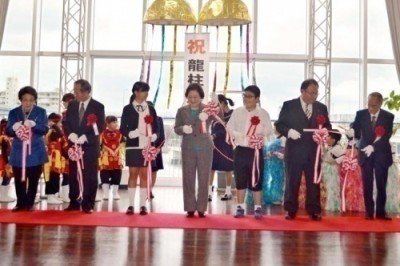
Mayor Shiroma (center) cuts the ribbon at the unveiling ceremony with other officials present on January 24 at Naha Cruise Terminal, Naha.
January 25, 2016 Ryukyu Shimpo
In yesterday’s election for mayor of Ginowan City, voters reelected the incumbent, pleased with his performance over the past four years and hoping he will continue to serve them well.
Throughout his campaign, the incumbent, Atsushi Sakima, avoided taking a stand on the Henoko base relocation issue. Thus, his reelection does not show that the voters accept the Henoko relocation plan, and is not a sign that the will of the Okinawan people has shifted in favor of the plan.
It is important to realize that the people of Ginowan are forcing the government to confront Sakima’s election pledge that U.S. Marine Corps Air Station (MCAS) Futenma be closed within five years of early 2014, when the pledge was made. The Abe administration supported Sakima in the election, and thus bears the responsibility of ensuring that operations at Futenma are halted by the deadline of February 2019.
The facts must not be distorted
Before the election, Prime Minister Abe flagrantly derided the importance of local opinion when he stated that matters of national security must be decided by the central government and would not be affected by a single local election. But now that opponent Keiichiro Shimura, who was backed by Okinawa governor Onaga’s ruling coalition, has been defeated, the Abe government will likely claim this shows that the people of Ginowan have expressed their support for the Henoko relocation. The government should avoid this unacceptable twisting of the facts.
At the end of December, the Ryukyu Shimpo participated in conducting a public opinion poll asking Ginowan residents for their views on the Henoko relocation. The results showed that 71.1 percent thought that MCAS Futenma should either be relocated outside of Okinawa, outside of Japan, or simply closed with no condition of a replacement.
Another poll conducted earlier this month showed that number at 74.4 percent. As for the Henoko relocation plan being pushed forward by the Japanese government, support remained low at 11.1 percent in the December poll and 12.9 percent in January. These numbers make it clear that the people of Ginowan do not wish for the construction of a new base in Henoko as a trade-off for closing Futenma.
Sakima won the election by pledging to prevent Futenma to remain in its current location permanently. The election results show the people’s rage at the Japanese government for remaining inert for a full twenty years since the 1996 agreement to close Futenma, while the base continues to endanger residents’ lives and wellbeing.
Mayor Sakima has the responsibility to realize the termination of operations at Futenma within five years from the time he made that promise. Nonetheless, there is a chance that this deadline will not be met.
Defense minister Gen Nakatani originally defined “termination of operations” as a complete cessation of all aircraft flights at the base. Meanwhile, Chief Cabinet Secretary Yoshihide Suga expressed his view that termination of operations would entail the cessation of (1) aerial refueling capabilities, (2) takeoffs and landings during times of emergency, and (3) Osprey aircraft operations. After hearing that, the defense minister took back his original statement, saying the government should not make statements that would delude the people.
When people demand the termination of Futenma operations, they seek the cessation of aircraft flights over their city. Sakima avowed that he would seek the closure and return of Futenma’s land to be realized as soon as possible.
Since the Abe government backed Sakima in the election, it must agree with his policies. In that case, it is only natural for the government to put its utmost efforts into realizing the closure of Futenma. Anything less would be a betrayal of the people’s trust.
Overcoming divisiveness
Over time, Okinawa has dealt with conflict over the base issue to the point of exhaustion. It seems Okinawa alone is forced to see its people turned against each other in such a way.
Political scientist Robert Putnam’s research on social capital has proven that if people lack a sense of unity, political policies will remain ineffective. The Japanese government has caused incalculable damage by scheming to create rifts within Okinawan society. We have had enough of such divisive schemes.
We hope that Mayor Sakima will endeavor to overcome such divisions. Open-minded magnanimity on Sakima’s part will help restore a sense of unity among Okinawans.
Recently, childhood poverty has gained visibility as a social problem in Okinawa. Ginowan is no exception. Ensuring the welfare and education of all children is a pressing issue. Children should not be forced to inherit the economic disparities present in their parents’ generation. We hope Mayor Sakima will come up with effective policies for tackling this situation.
In the Ginowan election, the policies of both candidates were strikingly similar. Both Sakima and Shimura advocated for free school lunches and free healthcare for children. These policies aim to improve children’s living environments, and they represent the candidates’ most important campaign pledges. We hope to see Mayor Sakima follow through on these promises in a timely manner.
Recently, people tend to assume that election pledges are simply meant to be broken. We hope Mayor Sakima will challenge this depressing assumption and renew our faith in politics. That is our greatest hope for one of the first critical elections in the first year since the voting age was lowered to 18.
(Enlish Translation by T&CT and Sandi Aritza)
Go to Japanese
January 22, 2016 Ryuyku Shimpo
On January 21, the Okinawa Prefectural Government (OPG) announced the number of tourist visits to Okinawa in the calendar year 2015. The number was 7,760,000, representing a 10 percent increase over the previous year and reaching a new high for three consecutive years. The number of foreign tourists increased by a considerable 68.8 percent over the previous year to 1,501,200. Meanwhile, the number of tourists coming from other areas of Japan virtually stagnated with a rise of just 1.6 percent, up to 6,261,800, due to the effects of typhoons. Mitsuyuki Maeda, Manager of the OPG Culture, Tourism and Sports Division, said, “The continuation of a weakened yen, the expansion of overseas airline routes, and increased porting of cruise ships have contributed to the considerable increase of foreign tourists.”
The number of tourists from Taiwan, which accounted for the largest number of foreign tourists, increased by 38.0 percent to 474,900. Those from China increased 2.5 times to 296,500. Visitors from South Korea increased by 92.1 percent to 297,900. Those from Hong Kong increased by 54.2 percent to 189,700.
The number of tourists coming from Tokyo remained unchanged from the previous year at 3,062,700. Those from Kansai increased by 5.4 percent to 1,310,500. Those from Fukuoka increased by 6.7 percent to 777,000. Those from Nagoya increased by 0.1 percent to 491,300.
For the 2016 forecast, Division Manager Maeda said, “We expect to compete with other tourist sites in Japan. Because of the expansion of routes by airline companies, the domestic travel market will steadily change. The number of foreign tourists will also build on solid growth due to the expansion of airline routes and increased porting of cruise ships.”
The number of tourist visits to Okinawa last December was up by 11.7 percent to 613,600 over the same period the previous year. Domestic tourists were up by 0.2 percent to 485,300, and foreign tourists were up by 98.3 percent to 128,300.
(English translation by T&CT and Megumi Chibana)
Go to Japanese
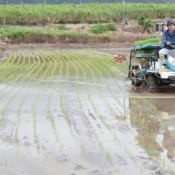
January 20, 2016 Ryukyu Shimpo
Japan’s earliest rice planting has now begun in the prefecture’s Yaeyama region, where most of the rice grown in Okinawa is produced. In Taketomi Town on Iriomote Island, 39-year-old rice farmer Kohkin Nishiohmasu started planting rice seedlings of the Hitomebore brand with his rice planter for the earliest harvest in the country. He plans to plant the seedlings in his 10-hectare rice paddies, aiming to harvest about 40 tons of rice. Nishiohmasu said, “I hope the planting will lead to a rich harvest.”
(English translation by T&CT and Sayaka Sakuma)
Go to Japanese
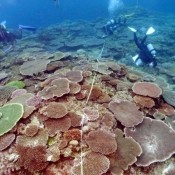
January 22, 2016 Ryukyu Shimpo
The Association for Protecting the Beautiful Sea of Okinawa carried out a survey to check the condition of coral reefs in Oura Bay, Nago City. The association surveyed two areas in the bay, including Chiribishi where staghorn coral is recovering from the near-extinction caused by El Nino in 1998. The surveys found coral reefs in the areas have recovered well.
The association surveyed Chiribishi over a range of 100 square meters. Focusing on a 50 meter-area where coral reefs thicken they found the degree of cover was 47.5 percent. The association surveyed the remaining 50 meter-area, where there is low coverage and they aim to restore the coral reefs, and found the coverage was only 8.8 percent. The total coral cover of the surveyed area was 28.1 percent.
Mariko Abe of the Nature Conservation Society of Japan said, “There are many Oratosquilla oratoria and butterfly fishes, fostering healthy habitats.” Masayuki Tamaei, co-leader of the Uminchu Association said, “I am looking forward to carrying out further surveys to see how coral reefs will recover.”
The degree of coral reef cover in Okinose area was 42.5 percent.
(English translation by T&CT)
Go to Japanese
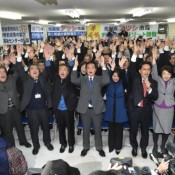
January 24, 2016 Ryukyu Shimpo
In the Ginowan mayoral election held on January 24, incumbent Atsushi Sakima, 51, who was seeking a second term and had the support of the Japanese government’s ruling parties, won against challenger Keiichiro Shimura, 63, a former prefectural government official who was backed by Okinawa Governor Takeshi Onaga and the prefectural assembly’s ruling parties. Sakima, who earned 27,668 votes, beat his opponent by a margin of 5,857 votes.
The main issue of the election was the Japan-U.S. plan to relocate U.S. Marine Corps Air Station Futenma from Ginowan to Henoko, Nago and the return of the land. It is speculated that the Abe administration in Tokyo will push ahead strongly with the construction work in Henoko after receiving the positive news of the victory of the incumbent candidate whom they supported.
Leaders of the ruling Liberal Democratic Party and Komei Party worked for the incumbent to get votes from corporations and organizations behind the scenes.
Members of the ruling parties of the city council practiced so called “dobuita senkyo” tactics for the incumbent, visiting houses in the communities to ask for support from voters. “Dobuita” means wooden boards laid across a ditch as a cover.
Regarding the Futenma base issue, the incumbent stressed that he would not allow the base to be left unchanged, avoiding Henoko becoming the focal point in the election campaign. Sakima succeeded in winning votes by highlighting his achievements in economic promotion and providing support to families raising children.
(English translation by T&CT)
Go to Japanese
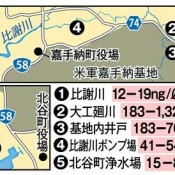
January 19, 2016 Ryukyu Shimpo
On January 18, Okinawa Prefectural Government (OPG) announced that an illegal chemical substance was found in Kadena Air Base water, Dakujaku River and Hija River. Dakujaku River runs through Okinawa City and Hija River runs through towns such as Kadena. OPG relies on Hija River to supply water for seven municipalities, including Naha. The OPG believes that the detected chemical substance most likely came from Kadena Air Base. At the press conference held at the prefectural government, Toshiaki Taira of the OPG announced that they will inspect Kadena Air Base for any usage of the chemical substance.
The chemical substance in question is Perfluorooctanesulfonic acid (PFOS), which is also found in aviation fuel and detergent. In Japan, using and importing the acid has been prohibited since 2010, when repetitive administration of PFOS caused deaths in animal experiments.
In Japan, PFOS concentrations in water are usually around 0.07-24 ng/L in any given natural environment. However, the OPG’s monthly survey of the water source at Chatan Water Purification Plant from February 2014 to November 2015 showed higher levels. In Dakujaku River, where the water drains from the air base, 183-1320 ng/L have been measured. In addition, 41-543 ng/L have been measured at the Hija River Pump Station, which takes in water from Hija River.
Meanwhile, 15-80 ng/L have been detected in purified water from Chatan Water Purification Plant. One of the plants main water sources is the Hija River and its purified water supplies seven municipalities. This concentration level is 300 ng/L lower than Germany’s health-related standard. There is no domestic standard in Japan yet. Taira says, “Although this will not cause any health issues immediately, we still need to take care of this situation. It is highly likely that this chemical is flowing in from Kadena Air Base. If this is the case, we will ask them to stop using it.”
(English Translation by T&CT, Kaya Doi)
Go to Japanese
January 7, 2016 Ryukyu Shimpo
The Department of Environmental Affairs of the prefectural government will carry out a survey on dugongs from fiscal year 2016 for two years. The animal is designated as a protected species in Japan. This will be the first investigation for dugongs by the prefectural government. The environmental affairs department wants to obtain information, including the number of the animals living and their habitats, in order to create a conservation plan for them.
The prefectural government plans to look into four areas, including off the coast of Henoko, Nago, Kin bay, and the sea near Kouri Island. Divers will look into dugong feeding sites. The prefectural government plans to carry out the investigation at several places and at different seasons to update the data.
In Japan, dugongs live only in the sea near the islands of Okinawa. It is known that a few individuals have their habitat off the coast of Henoko.
(English translation by T&CT, Hitomi Shinzato)
Go to Japanese
January 20, 2016 Ryukyu Shimpo
The Okinawa Prefectural Education Board has told the Japanese government’s Agency for Cultural Affairs its opposition to capturing and moving Coenobita hermit crabs living at Henoko, Nago. The Defense Ministry’s Okinawa bureau sent a request to the prefectural education board seeking approval to relocate the hermit crabs, designated a natural monument by the national government, in order to construct a new U.S. military base in Henoko. Under the Cultural Properties Protection Law, the prefectural education board must send a written opinion to the head of the Agency of Cultural Affairs.
This was revealed in a document obtained from a freedom-of-information request by Tsuyoshi Kitaueda, a member of the Peace Citizens’ Liaison Committee on January 19.
The prefectural education board indicated in the written opinion that a broad area of natural coast, which is a good habitat for the hermit crabs, would be lost irreversibly by the new base construction. And the board expressed its opposition to changing the current conditions.
However, the Agency for Cultural Affairs does not refer to the prefectural board’s opposition in a document giving its permission to allow the defense bureau to move the hermit crabs.
Kitaueda requested the prefectural board to look into and confirm this matter.
(English translation by T&CT)
Go to Japanese

January 19, 2016 Ryukyu Shimpo
Last month, the Committee for Settling National-Local Disputes dismissed the Okinawa prefectural government’s request for a review. The Okinawa prefectural government had requested that the Committee review the appropriateness of the Minister of Land, Infrastructure, Transport and Tourism (MLITT)’s decision to suspend execution of Governor Takeshi Onaga’s nullification of the permit to reclaim land in Henoko, Nago. On January 19, Governor Onaga held a news conference at the Okinawa Prefectural Office and announced the Okinawa prefectural government’s intention to file a lawsuit with the Naha district branch of the Fukuoka High Court against the Japanese government. Governor Onaga explained that the Committee dismissed Okinawa’s request without making any substantial determination about the legality, or lack thereof, of the MLITT’s action. The lawsuit will constitute a formal objection to the Committee’s decision.
A protest suit objecting to the Committee’s decision must be filed within thirty days of the Committee’s notification of decision. The Okinawa prefectural government will put together an official statement of objection during the next week or two, and the lawsuit will most likely be filed between February 1 and 3. This will be the third concurrent lawsuit between the Japanese national government and the Okinawa prefectural government regarding Governor Onaga’s nullification of the land reclamation permit.
(English translation by T&CT and Sandi Aritza)
Go to Japanese








 Webcam(Kokusai Street)
Webcam(Kokusai Street)


